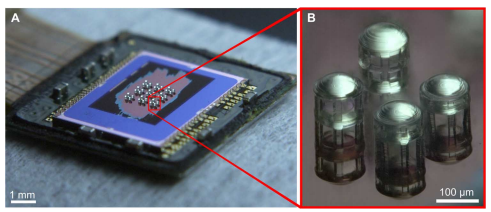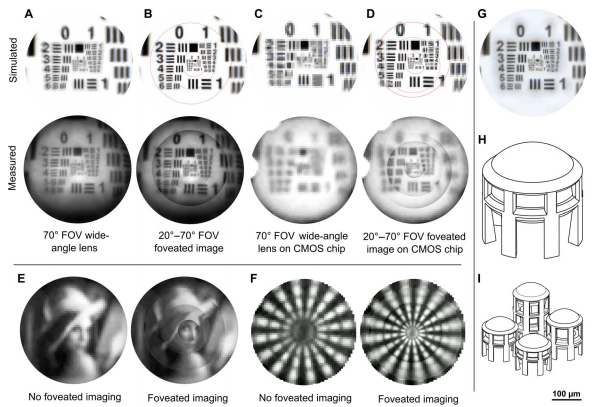 Seeing something out of the corner of one’s eye can be frustrating, especially if what you’re seeing is fleeting. That’s because the human eye is designed to focus on one small area at a time, while everything else remains blurred in the periphery. This kind of vision is called foveated vision, named for the fovea, which is a small spot at the back of each eye that is populated with a higher concentration of light-sensitive cells than the surrounding areas. Foveated vision is common to predators, allowing them to sweep their gaze across large areas while honing in on a central focal spot.
Seeing something out of the corner of one’s eye can be frustrating, especially if what you’re seeing is fleeting. That’s because the human eye is designed to focus on one small area at a time, while everything else remains blurred in the periphery. This kind of vision is called foveated vision, named for the fovea, which is a small spot at the back of each eye that is populated with a higher concentration of light-sensitive cells than the surrounding areas. Foveated vision is common to predators, allowing them to sweep their gaze across large areas while honing in on a central focal spot.
Eagles have especially deep foveae, giving them their famously sharp vision, and a group of scientists at the University of Stuttgart have managed to replicate that eagle-eye vision using a 3D printer to print four tiny plastic lenses of varying focal lengths directly onto a single image-sensing microchip. The lenses with longer focal lengths capture high detail over a narrow field of view, while the lenses with shorter focal lengths capture lower detail over a wider field of view.
Dr. Harald Giessen, a physics professor at the University of Stuttgart, used software to compile all of the image data captured from the four lenses into a single circular image that mimics the vision of a human – or eagle – eye: it’s sharply detailed in the center, but gradually loses focus towards the edges. The entire four-lens camera measures less than 300 micrometers squared – about the width of three human hairs – and Dr. Giessen says that the creation of such a small device would have been impossible without 3D printing.
“There is no chance you can manufacture imaging systems of this quality by any other means,” he says.
Dr. Giessen and his team have documented their work in a newly released study entitled “3D-printed eagle eye: Compound microlens system for foveated imaging.” A micro-camera like the one they designed could be used for a tiny drone, barely visible to the human eye, to carry out surveillance over wide ranges while focusing on particular areas of interest, or for numerous other purposes including sensors on driverless cars or even devices that could look inside the human body.
“Our work demonstrates for the first time direct 3D printing of varying complex multicomponent imaging systems onto a chip to form a multiaperture camera,” the research team explains. “We combine four different air-spaced doublet lenses to obtain a foveated imaging system with an FOV of 70° and angular resolutions of >2 cycles/deg in the center of the image. At the moment, the chip dimensions and pixel size limit the overall systems dimensions and our optical performance, whereas future devices can become smaller than 300 mm × 300 mm × 200 mm in volume and, at the same time, transfer images with higher resolution. The method thus enables considerably smaller imaging systems as compared to the state of the art.”
The science isn’t perfect yet; according to David J. Brady of Duke University, to get optimally clear images without any distortion would require using multiple types of plastic to print each lens. Unfortunately, while multi-material 3D printing is becoming more sophisticated, it’s still not possible to 3D print such small components in more than one material. It wouldn’t be surprising, though, to see the technology progress to that point before long.
“Further improvements would include antireflection coatings on the lenses, either by coatings or by nanostructuring; the use of triplets or more lens elements for aberration correction; and the inclusion of absorbing aperture stops,” the researchers add.
Additional authors of the study include Simon Thiele, Kathrin Arzenbacher, Timo Gissibl, and Alois M. Herkommer, who collaborated on a similar research project last year. You can access the full publication here. Discuss in the 3D Printed Lenses forum at 3DPB.com.
Subscribe to Our Email Newsletter
Stay up-to-date on all the latest news from the 3D printing industry and receive information and offers from third party vendors.
You May Also Like
3D Printing Financials: Fathom Struggles in Financial Quicksand During Critical Transition
Facing a year of key transitions and financial pressures, Fathom (Nasdaq: FTHM) has filed its annual report for 2023 with the U.S. Securities and Exchange Commission (SEC). The document outlines...
Latest Earnings Overview for Australian 3D Printing Firms Titomic and AML3D
Australian 3D printing manufacturing firms Titomic (ASX: TTT) and AML3D (ASX: AL3) reported their financial results for the period from July to December 2023, marking the first half of their...
3D Printing Webinar and Event Roundup: April 7, 2024
Webinars and events in the 3D printing industry are picking back up this week! Sea-Air-Space is coming to Maryland, and SAE International is sponsoring a 3D Systems webinar about 3D...
3D Printing Financials: Unpacking Farsoon and BLT’s 2023 Performance
In the Chinese 3D printing industry, two companies, Farsoon (SHA: 688433) and Bright Laser Technologies, or BLT (SHA: 688333), have recently unveiled their full-year earnings for 2023. Farsoon reported increases...


































